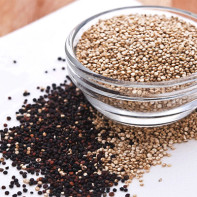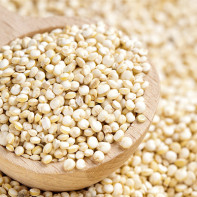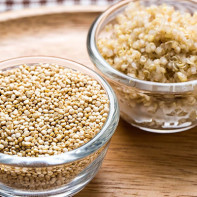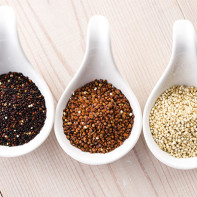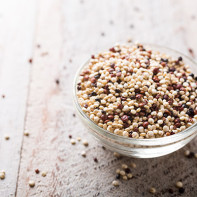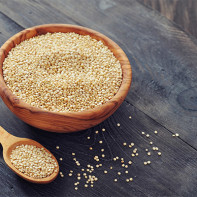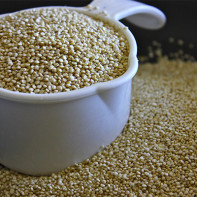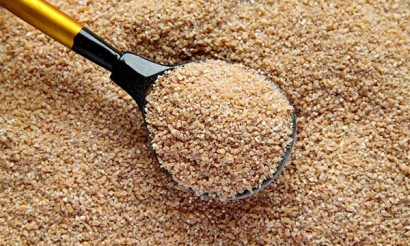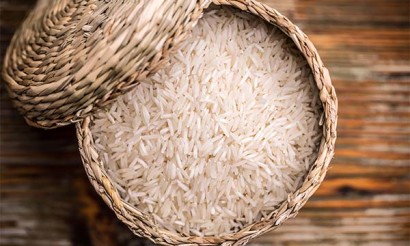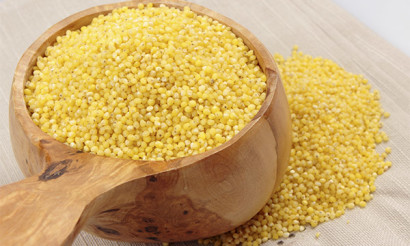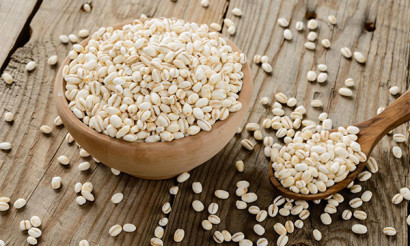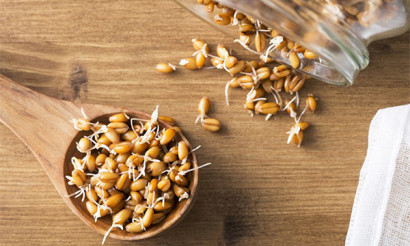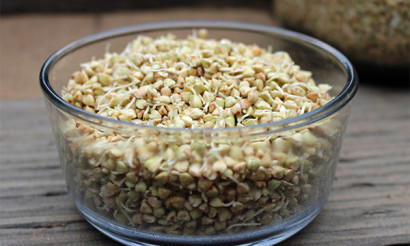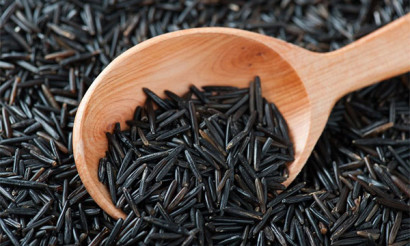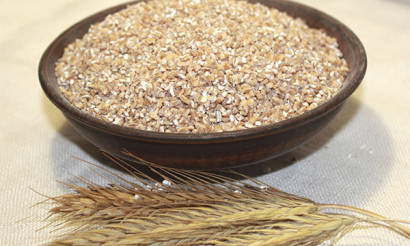Quinoa: what is it, composition, useful properties, how to cook it
Many people have heard of quinoa (quinoa), which is often called a superfood. We propose to learn in detail about its benefits, which have been recognized in health circles for quite some time, but have attracted the attention of the media only in the last few years.
- What is quinoa
- Composition and calories
- Useful properties of quinoa grits
- At what age are children allowed to eat quinoa
- The benefits and use of quinoa for weight loss
- Quinoa in Medicine
- Diabetes Mellitus
- In pancreatitis
- For gastritis and intestines
- With gout
- Quinoa Grits in Cosmetology
- The Benefits and Uses of Quinoa Flour
- How to choose flour
- Culinary Use of Quinoa Flour
- How to Store Quinoa Flour
- Health Benefits of Quinoa Flour
- Harms and contraindications
- How to choose and store quinoa
- How to cook quinoa: Recipes
- The healthiest way to cook quinoa
- Recipe for baby food: Porridge from quinoa
- Grilled salmon with coleslaw and quinoa
- Interesting Facts about Quinoa
What is quinoa
This grain has become popular among health-conscious people because of its various benefits, including high amounts of protein, fiber, vitamins and minerals. It is rich in magnesium, iron, B vitamins, calcium, potassium, phosphorus, vitamin E and various antioxidants. It is gluten-free and recommended for people who are on a gluten-free diet.
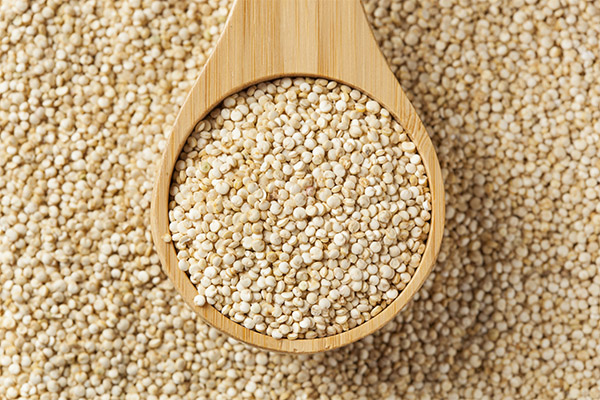
Quinoa is a grain crop grown mainly for its edible seeds. The plant is a variety of the genus goosefoot (Chenopodium quinoa), which originated in the Lake Titicaca region of Peru and Bolivia. Domestication dates back to 3,000 to 5,000 years B.C., when it began to be bred by the peoples of the Americas, according to existing historical data. In addition, there is archaeological evidence of quinoa in the tombs of Arica in Chile, Tarapaca, Calama, and various regions of Peru. At this time pre-Columbian civilizations grew and used quinoa as a staple food.
The most common types include white, red and black quinoa. In addition to the uniqueness of color, the different varieties yield different flavors and textures. White quinoa is the most common, with a smoother texture than red quinoa, which is most often used in cold salads. Black quinoa is slightly earthier and sweeter than mild white quinoa.
Composition and calories
The caloric value of quinoa is 368 kcal per 100 grams of product.
Fats are contained in small amounts. They are polyunsaturated and monounsaturated.
Quinoa is a complete protein, with about 8 grams per serving. Whole proteins are those that contain all 9 essential amino acids.
Quinoa is gluten-free, rich in protein and one of the few plant foods that contain all 9 essential amino acids. Quinoa is also rich in fiber, magnesium, B vitamins, potassium, calcium, iron, phosphorus, vitamin E and various beneficial antioxidants. Certain types known as phytoestrogens have been studied in the treatment of menopausal symptoms because they sometimes have the ability to behave like estrogens in the body.
By including quinoa grits in your diet, you will certainly increase your overall intake of these nutrients as well as other important plant components.
Unlike many grains, quinoa is very rich in fiber. In one study conducted at the University of Valencia in Spain, 4 varieties of quinoa were used to determine the amount of fiber. They averaged 10 to 16 grams of fiber for every 100 grams of cereal.
This grain is non-GMO and is usually grown organically.
Useful properties of quinoa grits
Low sodium quinoa is rich in fiber and protein. Fiber is the non-digestible part of carbohydrates that helps satiate the body and relieve feelings of hunger. This cereal porridge prevents and eases constipation and can help lower cholesterol, which is good for the heart. It is indicated for maintaining stable blood sugar levels.
Studies show that the risk of type 2 diabetes is lower with frequent consumption of whole grains. Is an alternative to pasta to satisfy cravings for starch.
Quinoa porridge would be good for athletes. Not only do muscles need protein to function properly and grow, but they also need other nutrients such as iron, which also helps maintain healthy muscle metabolism.
Quinoa in Breastfeeding and Pregnancy
Because of its high nutrient content, quinoa is recommended for women during pregnancy. The cereal will fill the body with vitamins and minerals, as well as help restore strength, reduce appetite, and avoid anemia.
Quinoa is recommended for breastfeeding to help produce milk and saturate it with nutrients. Since porridge from this cereal does not contain gluten, the possibility of an allergic reaction to this dish is minimized.
At what age are children allowed to eat quinoa?
It is not recommended to feed quinoa to children under the age of 2 years, despite all its advantages. The grits contain saponins, which are toxic for babies and irritate the intestines. After 2 years, you can add porridge from this cereal to the diet.
Benefits and use of quinoa for weight loss
Quinoa today is a trend of healthy food, and it has become one of the main ingredients in the diet of many people who care about their health. And it is not surprising: the cereal porridge gives a feeling of fullness for a long time and has a neutral taste. Also, the cereal contains some nutrients that can help you lose extra pounds, so it is a useful addition to weight loss diets, the main thing is to watch the portion size.
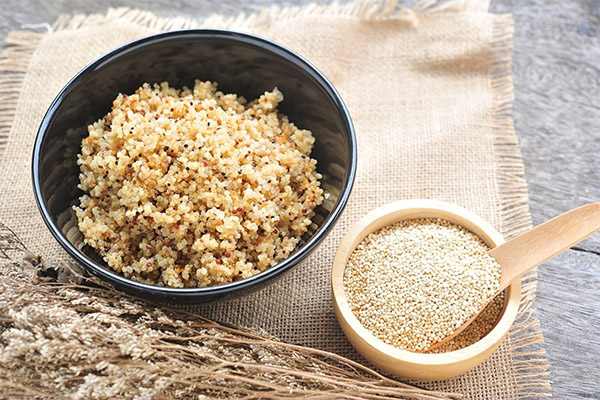
The evidence for quinoa's effectiveness in weight loss is clear.
- There is some preliminary evidence directly linking quinoa to weight loss. One study published in the journal Food Science and Technology in 2015 looked at the effect of quinoa on appetite in lab rats. The study authors found that rats fed quinoa grits ate less food overall than rats that did not eat the grits.
- Other studies suggest that 20-hydroxyecdysone, one of the compounds found in quinoa, may help with weight control. One animal study published in the journal Psychology and Behavior found that mice fed quinoa extract high in 20-hydroxyecdysone burned more calories throughout the day and absorbed less fat from their diet.
In another study published in 2012 on obesity, it was found that mice who received a high 20-hydroxyecdysone quinoa extract were less likely to gain weight on a high-fat diet than mice who did not receive the extract. While this study is promising, it's too early to tell if quinoa has the same benefits for humans.
If you want to lose weight deliciously, you can serve quinoa topped with a nutritious pesto of mixed kale, almonds and olive oil for a healthy side dish filled with greens. Or make a quinoa salad for lunch by mixing it with stewed zucchini, bell peppers, onions, mushrooms, eggplant and a homemade vinaigrette with lemon and basil.
Quinoa in medicine
For diabetes.
Diabetics must be consistent and careful with their diets to keep their blood sugar levels at the right levels. If you don't pay attention to your diet, you can easily raise your blood sugar levels and end up facing serious and dangerous complications of the disease.
Quinoa grains are ideal for diabetics for their perpetual chronic fatigue. This cereal has a low glycemic index (53 units). This means that the cereal will not raise blood sugar levels of a diabetic. Quinoa is also high in magnesium, which is known to help those with this disease. A study published by the American Diabetes Association shows that oral magnesium supplements improve insulin sensitivity and metabolism in patients with type 2 diabetes. Hypomagnesemia is a condition in which blood magnesium levels are low. This condition is common among diabetics. Although such supplements are controversial and should be prescribed by a doctor!
For pancreatitis
The chronic pancreatitis diet is the number one strategy recommended for patients diagnosed with an inflamed pancreas. Pancreatitis is more common in adults because of alcohol abuse, because of gallstone disease, but childhood pancreatitis is not uncommon because of many genetic factors and improper nutrition.
The pancreatitis diet plan is designed to address digestive enzyme and insulin deficiencies in some cases. The diet for chronic pancreatitis should include 4-5 small and frequent meals throughout the day. Alcohol, tobacco, carbonated drinks, fruit juices, and drinks with caffeine are highly undesirable because they tend to overstimulate the pancreas.
The complex carbohydrates that are in quinoa are acceptable in chronic pancreatitis - the porridge is consumed 1-2 times a week with the addition of cold-pressed olive oil. The dish of this cereal has a coating effect, which promotes the digestion of food, while not irritating the mucosa of the stomach.
In the acute form of pancreatitis do not eat quinoa.
For gastritis and for the intestines
People with acute gastritis should give up quinoa, as you can not consume it during an exacerbation. When the disease is chronic and not disturbed by symptoms, grains are acceptable in the diet 3 times a week.
Quinoa is usually cooked for 7-8 minutes - this cooking time is fine for a healthy person. However, for a patient with gastritis, the porridge should be more cooked to become viscous, so as to envelop the inner walls of the stomach. It is the viscosity of the porridge that is necessary for the treatment of gastritis. Undercooked quinoa can only make the disease worse. Instead of digesting the food quickly, the stomach will load up, trying to extract the necessary amount of acid to digest the food.
Quinoa does not cause gastrointestinal distress. However, this grain should not be abused.
For gout.
Do not use quinoa for gout and acute phases of urolithiasis.
Quinoa Grits in Cosmetology
The International Journal of Dermatology found that the zinc found in quinoa plays a supporting antioxidant role in protecting against oxidative damage caused by free radicals. Zinc protects against ultraviolet radiation and improves wound healing. Researchers have concluded that zinc ions can provide important and beneficial antioxidant protection to the skin. Quinoa oil is used for cosmetic purposes, which has a healing effect as well as smoothing the skin and removing fine lines and wrinkles.
Cosmetologists also use quinoa as a scrub to combat cellulite.
The benefits and uses of quinoa flour
Flour is made by grinding quinoa grains into smaller particles. Its color ranges from creamy yellow to ivory. There are different kinds, such as red and black quinoa, but white is most commonly used.
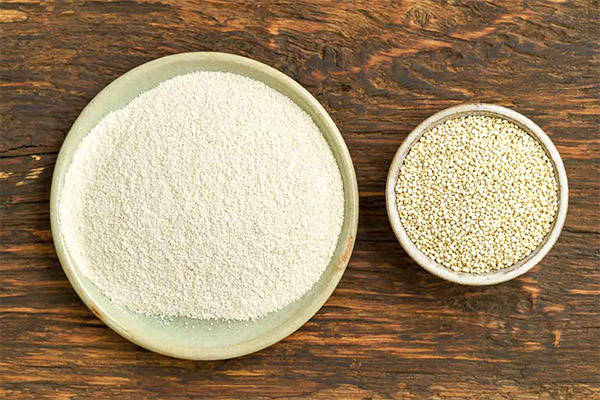
Quinoa flour is very expensive, so people buy whole grains in bulk and turn them into flour themselves by grinding them at home in a food processor or mill to their specifications. Such flour is a safe option for those who are gluten intolerant.
How to choose flour
- Read the label, make sure it says "quinoa flour" and check the expiration date.
- Examine the packaging for damage.
- If the package is clear, you should look inside to see if the flour is really yellowish or creamy, and it should be as crushed as possible. The flour should not look lumpy.
Culinary Use of Quinoa Flour
- This flour is used to make gluten-free breads and other baked goods such as pancakes, muffins, pizza bases, pie crusts, etc.
- Usually used in combination with other flours.
- Can be used to thicken sauces, soups, etc.
How to Store Quinoa Flour
- Store in an airtight container.
- Some people also store quinoa flour in the refrigerator, in an airtight container, or freeze it to use when needed.
Health benefits of quinoa flour
- Weight loss: the high fiber content of quinoa is a major nutrient that promotes weight loss. Meals prepared with this flour are high in protein, which further helps to increase our metabolism and reduce appetite. Decent weight loss is achieved with regular consumption of quinoa and eliminating baked goods made from regular wheat flour.
- Blood sugar control: Quinoa with a low glycemic index of 53 is considered a safe product for diabetics. Foods with a low glycemic index do not contribute to a rapid rise in blood sugar levels, which helps fight the insidious disease.
Harms and contraindications
- Quinoa is contraindicated for individual intolerance and with kidney problems, people with urolithiasis and gout.
- Do not give quinoa porridge to children under 2 years of age.
How to choose and store quinoa
White quinoa is the most common type of grain you'll find in most stores, although red and black are also becoming available in larger cities. As for the choice of groats, there is only one rule: check the expiration date indicated by the manufacturer on the package and its integrity.
It is best to store quinoa in an airtight glass or plastic container, in which case it will be preserved for a longer period of time, about three to six months.
How to cook quinoa: recipes
Whatever dish you cook with this cereal, it should first be thoroughly rinsed under running water. This will rid the grains of dust, as well as remove the possible taste of bitterness, which can appear after boiling the porridge.
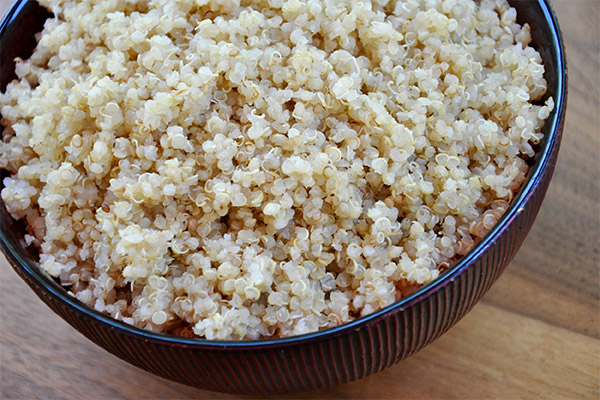
The healthiest way to cook quinoa
To make quinoa, add one part grain to two parts water in a pot. Once the mixture is brought to a boil, reduce the heat, cook over low heat and cover with a lid. It usually takes 15 minutes to cook one cup of quinoa using this method. When the cooking is done, the grains will be translucent and the white germ will partially separate, looking like a white spiral tail.
If you want the quinoa to have a more nutty flavor, you can roast it before cooking. You need to place it in a skillet (stove over medium heat) and stir constantly for 5 minutes.
Recent studies on cooking quinoa have compared cooking and steaming methods to evaluate the effects of food processing on vitamin B. The good news is that the folic acid in the grits appears to be well preserved with either cooking method.
Quinoa flour is another product that is becoming increasingly available in supermarkets. Although baked goods and pasta can be made with 100 percent quinoa flour, many quinoa companies combine it with other types (such as tapioca flour, rice flour or even oat flour) for a lighter texture. When making baked goods at home, you can experiment.
Recipe for baby food: quinoa porridge
Ingredients:
- 1 cup whole quinoa (unground).
- 2 cups water.
Preparation:
- In a large saucepan, bring 2 cups of water to a boil.
- Add 1 cup quinoa.
- Cover the pot, reduce the heat, and simmer for about 15 minutes. Let stand for five minutes.
You can add spices such as cinnamon, ginger and vanilla as well as fruits, vegetables or other foods appropriate for the child's age.
Roasted salmon with coleslaw and quinoa
Ingredients:
- 1 salmon fillet - approximately 500 grams;
- 1 teaspoon olive oil;
- 1/8 teaspoon salt;
- 1/8 teaspoon freshly ground black pepper;
- 2 cups thinly sliced lacinato cabbage;
- 1/2 cup cooked quinoa.
How to prepare the dish:
- Preheat oven to 320ºC.
- Place the salmon on a baking tray covered with foil. Mash evenly with oil, salt and pepper. Bake at the above temperature for 10 minutes, until the fish flakes easily when tested with a fork.
- While fish is cooking, mix kale, quinoa, all-purpose citrus dressing and grapes in a bowl. Allow to stand for 5 minutes. Place salmon on top.
What else can be made with quinoa
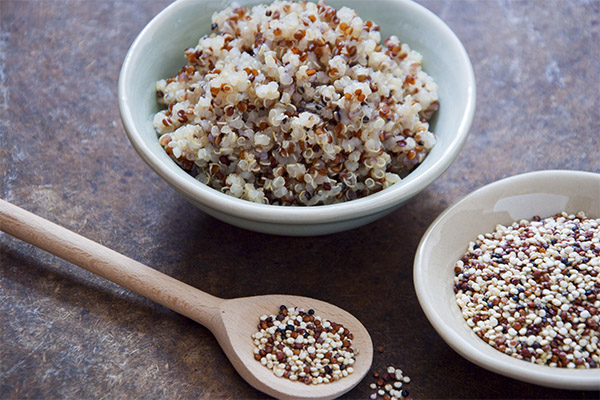
- Meat pilaf. According to the traditional scheme, prepare a rich broth of any meat (800 g), onion and carrot, spices (coriander, zira, barberry, etc.). In 10 minutes add tomato paste or tomatoes, add 2 cups of seeds and add water so that it towers over the mass by 1.5 cm. Cover and simmer for about 30 minutes.
- Vegetable Garnish. Boil 200g of the seeds in salted water. Fry 2 zucchini, a couple of carrots, 1 head of red onion and stalk of young celery in butter. Combine the vegetables with the porridge and dress with sauce (100 ml of citrus fruit + paprika).
- Canapés with fish. Take 40g of grits and boil until tender. Slice baguette and fry it in butter. Mix boiled seeds with chopped pickled herring or mackerel (50 g) and a piece of butter. Place the minced meat on the croutons, garnish with fresh cucumber and a sprig of herbs.
- Energy Breakfast. Steep a couple of tablespoons of coconut shavings. Boil the separated milk, combine with spices (vanilla, cinnamon) and add 100 g of quinoa seeds. When the porridge absorbs all the liquid, add the dried fruit, cover and steam for 5 minutes. You can garnish with a banana before serving.
- Vegetarian salad. Boil a cup of seeds. Also boil 10 asparagus stalks separately, chop them into pieces. Dice 1 grapefruit. Combine the ingredients and dress with the sauce (4 tablespoons of olive oil, the freshness of half a lemon, salt and pepper, chopped greens).
Interesting facts about quinoa
Despite its growing popularity, most people don't know much about this ancient grain. Here are some fun facts about the popular superfood.
- Quinoa is not actually a grain. We cook and eat quinoa like many other grains, but botanically it is a relative of spinach, chard, and beets. The part we eat is actually the seed. Its leaves are also edible.
- Quinoa is a complete protein. As far back as 1955, research confirmed the crop's nutritional properties.
- There are about 120 known species of quinoa. The commercial ones are white, black and red.
«Important: All information on this site is provided for informational purposes only information on this site is provided for educational purposes only. Talk to your health care professional before following any recommendations. professional before using any of the recommendations. Neither the editors nor the authors shall be liable for any possible harm caused by materials."

